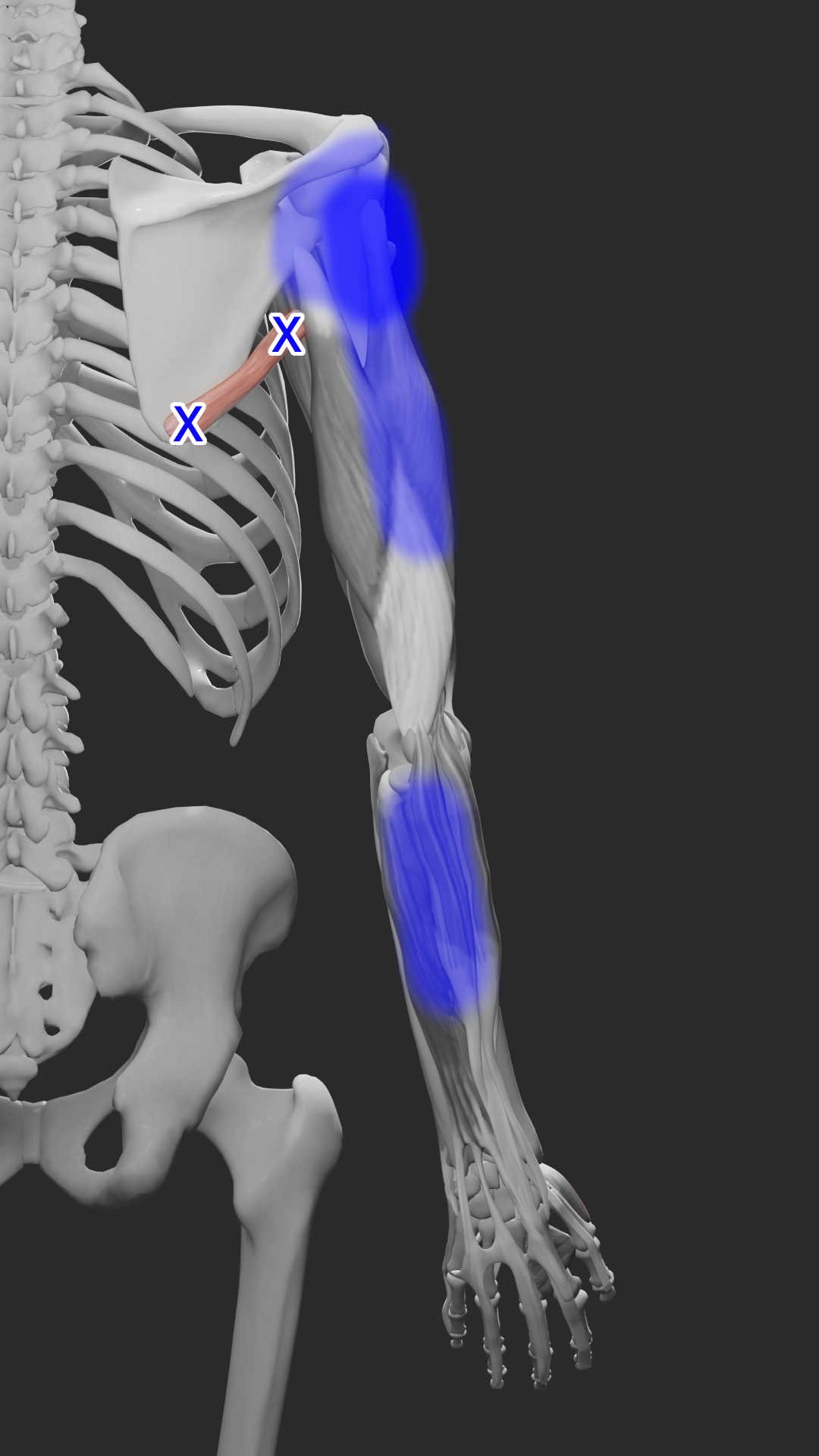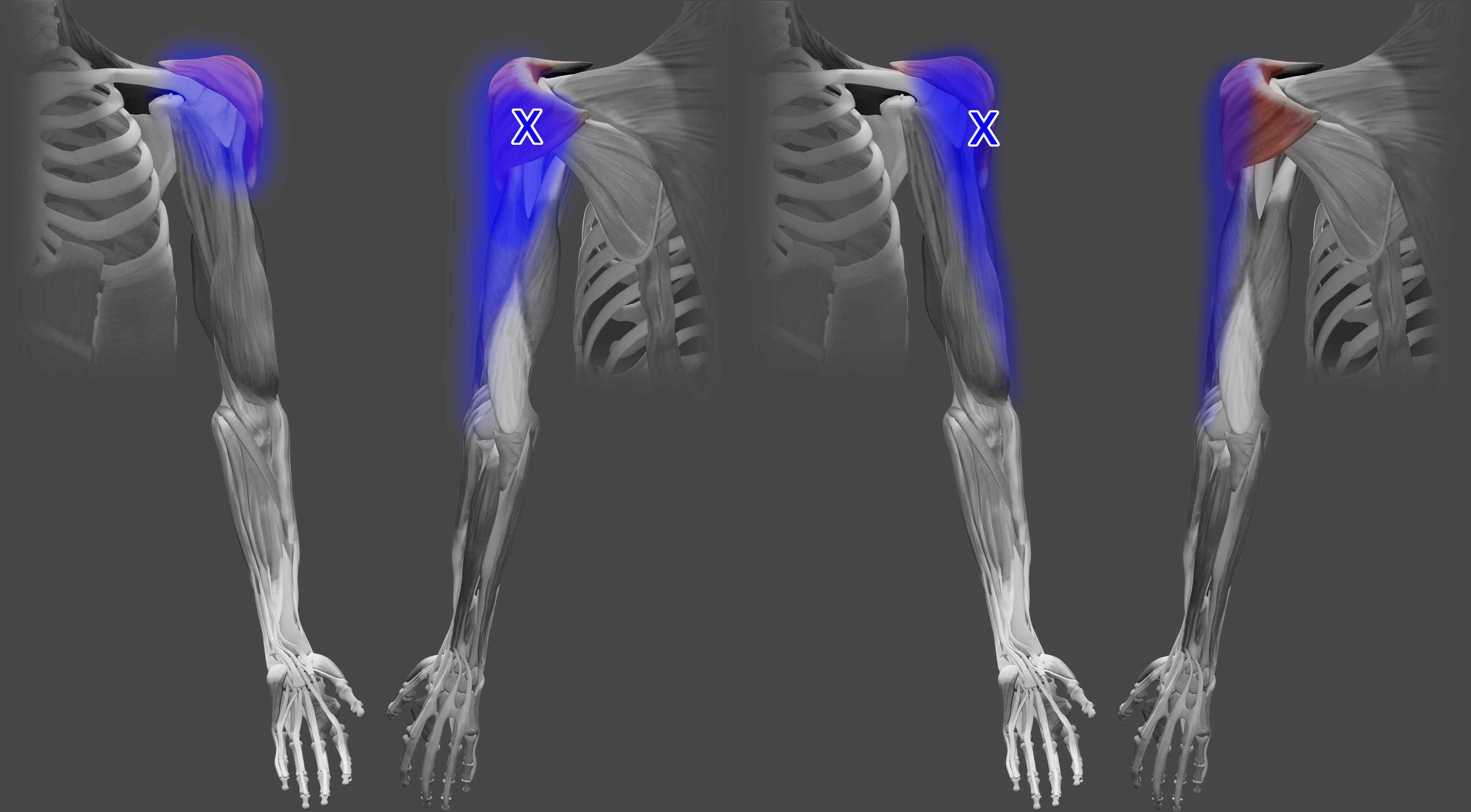Acupuncture for Subscapularis Pain
A person with back of shoulder pain
Effective Treatment for Subscapularis Muscle Pain
Do you often feel pain in the back of your arm or deep within your shoulder? Struggling with tasks that involve lifting or internal rotation of the arm, such as placing items on a high shelf or throwing a ball? It's possible that you're experiencing subscapularis pain. In this blog post, we will explore this muscle, its trigger points, and why acupuncture and dry needling might be the solution you've been searching for.
What is the Subscapularis Muscle?
The subscapularis muscle is a large, triangular muscle located in the upper back, just underneath the scapula (shoulder blade). It is one of the four rotator cuff muscles and is responsible for rotating the arm inward (internal rotation) and stabilizing the shoulder joint. It is the largest and strongest rotator cuff muscle and is the only one to medially rotate the shoulder. Compared to the other rotator cuff muscles, the frequency of subscapularis tears is less than the other rotator cuff muscles.
More specifically, the muscle is located on the anterior (front) surface of the scapula, which is the triangular bone in the upper back that forms part of the shoulder. It occupies the subscapular fossa, a concave depression on the costal (front) side of the scapula. This positioning places it directly against the rib cage, underneath the scapula. This makes it a hard muscle to access since it is on the inside of the shoulder blade underneath the ribs from the front of the body.
Trigger points and pain in the subscapularis muscle can develop as a result of overuse, injury, or poor posture, and can cause pain, weakness, and limited range of motion in the shoulder. Common symptoms of trigger points in the muscle include pain in the front of the shoulder or near the armpit, pain or discomfort when reaching overhead, and pain or discomfort when lying on the affected side.
Is the Subscapularis part of the rotator cuff?
Yes, the subscapularis is one of the four rotator cuff muscles. The rotator cuff is made up of the:
Supraspinatus
Subscapularis
Subscapularis and shoulder anatomy
Common Indications for Subscapularis Trigger Points
Back of Arm Pain
Back of Shoulder Pain
Carpal Tunnel-like Pain in Wrist (watchband area)
Dorsal Wrist & Hand Pain
Problems Holding Arms Up (as when folding sheets)
Subscapularis Actions
Medially rotates the shoulder
Stabilizes humeral head (shoulder joint)
The main subscapularis function is to interally rotate the shoulder and stabilize the shoulder.
Subscapularis Origin and Insertion
Subscapularis Origin
Subscapular fossa of the scapula
Subscapularis Insertion
Lesser tubercle of the humerus
Signs and Symptoms of Subscapularis Trigger Points
Pain both when arm in motion and resting
Pain or restricted shoulder abduction
Difficulty getting dressed
Can't reach up and forward
Unable to reach to opposite armpit
Causes of Subscapularis Pain
Overuse or trauma to a muscle is a common cause, here are some specific to this muscle:
Sudden overload - reaching back to break a fall
Any injury or dislocation to shoulder joint
Prolonged immobilization of the shoulder in a medially rotated and adducted position
Excessive overhead lifting
Repetitive motion involving internal rotation (swimming or throwing ball)
Slumped forward head posture which leads to excessive internal rotation of the shoulder
Subscapularis Trigger Points
Subscapularis trigger points
Where are Subscapularis Trigger Points?
One trigger point is found in the posterior axillary fold where the latissimus dorsi muscle meets the teres major.
Another trigger point is positioned over the back surface of the lower scapula.
The third trigger point is near the point where the muscle connects to the tendon on the lateral side.
Subscapularis Trigger Point Referral Pattern
Subscapularis pain referral concentrates in the posterior deltoid and shoulder area and may extend medially over the scapula, down the posterior aspect of arm and then skip to a band around wrist.
Associated Trigger Points
Pectoralis major
Teres major
Latissimus dorsi
Triceps brachii (long head)
Differential Diagnosis
Pain in the back of the shoulder is fairly common, so it's also essential to rule out other potential causes such as:
Frozen shoulder
Adhesive capsulitis
Rotator cuff tear
Shoulder impingement
Cervical radiculopathy
Thoracic outlet syndrome
Synergists and Antagonists
Synergists:
Teres major: due to similar attachment on scapula and humerus
Latissimus dorsi: and pectoralis major for medial rotation
Rotator cuff muscles: to stabilize shoulder and produce compressive forces for concavity compression
Antagonists:
Lateral rotators such as the infraspinatus, teres minor, and the posterior deltoid.
Treatment for Subscapularis Pain
Acupuncture and dry needling are effective treatments for relieving muscle pain and deactivating trigger points. If you have pain or an issue like subscapularis tendinitis, strain, or tear - acupuncture and dry needling can offer a safe and direct way to address your issue.
Treatment for patients with a diagnosis of frozen shoulder often an involves and examination of the subscapularis muscle. There is a strong association between subscapularis trigger points and a frozen shoulder diagnosis. Treating subscapularis trigger points may alleviate symptoms of frozen shoulder or adhesive capsulitis. The primary symptoms of subscapularis trigger points result in pain and restricted range of motion of the shoulder, which are the same criteria for a diagnosis of "frozen shoulder" by many health professionals.
Subscapularis muscle pain may also mimic thoracic outlet syndrome pain - and is one of the four muscles that contribute to what is known as “myofascial pseudothoracic outlet syndrome.” According to Travell and Simons, a combination of trigger points in the subscapularis, latissimus dorsi, teres major, and pectoralis major muscles can cause this type of pain.
Patients experiencing active trigger points in at least three muscles of the above mentioned muscles, including the subscapularis, often present symptoms resembling myofascial pseudothoracic outlet syndrome (pseudo-TOS). This condition can be easily mistaken for a range of other diagnoses, such as thoracic outlet syndrome, multiple-level cervical radiculopathy, various types of shoulder bursitis, or tendinitis. Often, patients misdiagnosed with these conditions continue to experience discomfort and frustration due to untreated muscular sources of pain. Notably, the subscapularis and associated muscles are predominantly strong internal shoulder rotation muscles, which play a significant role in this syndrome.
Corrective Actions
Avoidance of prolonged shortening (medial rotation of shoulder) of the muscle both at night and during the daytime,
Avoidance of a "slumped" forward posture
Subscapularis stretches
Assessing range of motion by internally and externally rotating the shoulder, as well as muscle specific tests like the lift off test, belly press test and bear hug test can determine the extent of the issue.
Final Thoughts
In conclusion, understanding the complexities of subscapularis muscle pain is key to effective treatment and recovery. At Morningside Acupuncture, we recognize that pain in this crucial rotator cuff muscle can significantly impact your daily life, often mimicking or contributing to conditions like frozen shoulder or thoracic outlet syndrome. Our approach, incorporating traditional acupuncture and dry needling, directly addresses subscapularis trigger points, offering relief from pain and restricted motion.
Our treatments are tailored to not only alleviate the immediate symptoms but also to tackle the root causes, including postural imbalances and repetitive strain.
For those struggling with symptoms that align with subscapularis pain, we invite you to experience the benefits of our specialized care. Schedule a consultation today and take the first step towards effective relief and long-term recovery.
Over to you
If you liked this article, please share with friends and family who may be suffering with shoulder pain.
Sources:
Travell, J. G., Simons, D. G. (1993). Myofascial pain and dysfunction: The trigger point manual. London: Lippincott Williams & Wilkins.
Biel, A., & Dorn, R. (2010). Trail guide to the body: A hands-on guide to locating muscles, bones and more. Boulder, CO: Books of Dicovery.
Janda, Vladimír. “Muscle Function Testing.” (1983).
Aguirre K, Mudreac A, Kiel J. Anatomy, Shoulder and Upper Limb, Subscapularis Muscle. [Updated 2023 Aug 28]. In: StatPearls [Internet]. Treasure Island (FL): StatPearls Publishing; 2023 Jan-. Available from: https://www.ncbi.nlm.nih.gov/books/NBK513344/
M.V. Arjun, S. Rajaseker, Association between subscapularis trigger point and frozen shoulder: A cross sectional study, Journal of Bodywork and Movement Therapies, Volume 28, 2021, Pages 406-410, ISSN 1360-8592, https://www.bodyworkmovementtherapies.com/article/S1360-8592(21)00144-3/abstract. (https://www.sciencedirect.com/science/article/pii/S1360859221001443)
Fernández-de-Las-Peñas, C., & Nijs, J. (2019). Trigger point dry needling for the treatment of myofascial pain syndrome: current perspectives within a pain neuroscience paradigm. Journal of pain research, 12, 1899–1911. https://doi.org/10.2147/JPR.S154728
Disclaimer: This web site is intended for educational and informational purposes only. Reading this website does not constitute providing medical advice or any professional services. This information should not be used for diagnosing or treating any health issue or disease. Those seeking medical advice should consult with a licensed physician. Seek the advice of a medical doctor or other qualified health professional for any medical condition. If you think you have a medical emergency, call 911 or go to the emergency room. No acupuncturist-patient relationship is created by reading this website or using the information. Morningside Acupuncture PLLC and its employees and contributors do not make any express or implied representations with respect to the information on this site or its use.





